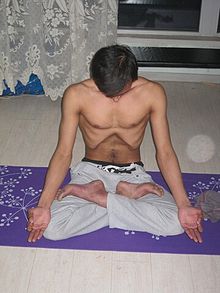Bandha

Bandha ( Sanskrit : बन्ध bandha m. "Bond") is a practice in Hatha Yoga , in which the energy ( prana ) in the body is to be retained by contracting certain muscles . The bandhas are often performed together with yogic breathing exercises ( pranayama ), especially during the phase of holding your breath (kumbhaka). In Hatha Yoga the bandhas belong to the mudras , with the bandhas the energies or the prana are controlled.
The four bandhas
Four different bandhas are traditionally described:
- Mulabandha ( Sanskrit मूलबन्ध mūla-bandha, contraction of the base or root, mula) or "root lock": By contraction of the muscles in the anus area or the pelvic floor , the drainage of energy through the anus is to be prevented. Mulabandha also serves to awaken Kundalini energy.
- Uddiyanabandha (Sanskrit, उड्डीयानबन्ध uḍḍīyānabandha, the closure of the fly-up) or "high-fly closure": The abdomen is strongly drawn in and the diaphragm is raised. This is supposed to push the energy up through the sushumna , the most important energy channel ( nadi ) running through the spine . In addition, this bandha should counteract the lowering of the abdominal viscera. Uddiyanabandha is also used to practice nauli .
- Jalandharabandha (Sanskrit, जालन्धरबन्ध jālandharabandha, the chin lock, throat lock) or neck lock: the chin is pressed into the hollow between the collarbones. This prevents energy from escaping upwards.
- Mahabandha (Sanskrit, महाबन्ध mahābandha, large or complete closure) or "large closure": While the left foot is pressed to the perineum and the right foot is placed on the left thigh, all three bandhas are performed simultaneously. Mahabandha is considered an advanced practice and is used for Kundalini awakening.
Bandhas and Granthis
In the asanas , the bandhas also serve to break or loosen the granthis or knots in order to be able to lead the Kundalini or life energy through the Sushumna Nadi. Thus three main Granthis are described analogously to the Bandhas.
Lore
The bandhas are mentioned in various Hatha Yoga scriptures. The Gorakshashataka (10th century) briefly describes Mula, Uddiyana and Jalandharabandha and their effects (verses 57-63). The Hathayogapradipika (14th century) describes in detail the Mulabandha (III, 19-25) and Uddiyana, Mula and Jalandharabandha (III, 55-78) and names the latter the "three best bandhas" that were used by the "great sages" be practiced.
literature
- Wilfried Huchzermeyer : The Yoga Lexicon . edition sawitri, Karlsruhe (2009). ISBN 978-3-931172-28-2
- Swami Satyananda Saraswati: Asana Pranayama Mudra Bandha. Ananda Publishing House; 2001 4 , ISBN 3-928831-17-8
Individual evidence
- ↑ Fausta Nowotny: The Gorakṣaśataka . Cologne 1976. p. 102
- ↑ Swami Svâtmârâma: Hatha-Yoga Pradipikâ . Neuenkirchen: Phenomenon-Verlag (2007). ISBN 978-3-933321-61-9 .